Walt Disney Television Animation/DQ Enterprises, Limited (2006), Walt Disney Home Entertainment (November 14, 2006), single disc, 72 mins plus supplements, 1.33:1 original full frame ratio, Dolby Digital 2.0, Rated G, Retail: $19.99
Storyboard:
Mickey and his friends at the clubhouse are asked by Mrs. Claus to help save Santa in time for Christmas. Two more episodes see Mickey and Goofy help a little lost bird, and Mickey find Donald in a game of hide-and-go-seek.
The Sweatbox Review:
Having not seen Mickey Mouse Clubhouse before, my expectations for this show were set largely by having seen Mickey’s Twice Upon A Christmas, a 2004 direct-to-video effort that saw Mickey and the gang go all-CGI, forsaking the cosiness of pencil and ink for the splashy modern-ness of pixels. I had, after all, seen on the back cover of Mickey Saves Santa that this DVD was undoubtedly computer-animated. I felt like I was one of the few out there that enjoyed Mickey’s Twice Upon A Christmas, with many others citing their aversion to seeing Mickey and his pals animated on computers, not to mention the final product, which was accused of appearing cheap and awkwardly animated. My opinion, as I said, varied from those people, as I found Twice Upon to be charming and enjoyable, though like any anthology some parts were stronger than others. I was probably being a little lenient, too, considering as I was the fact that that was the very first major Mickey Mouse product that had been tried using computer techniques (aside from computer games and an Oscars telecast). I would still prefer to see Mickey done traditionally, but the futurist in me was curious as to what would come next. And now here’s my answer.
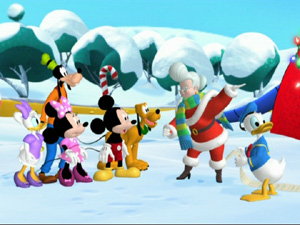
Mickey Mouse Clubhouse debuted on the Playhouse Disney programming block of The Disney Channel in spring of 2006. Targeted at preschoolers, the show turns out to be much closer in tone to Blue’s Clues or Dora The Explorer than the more family-oriented Twice Upon A Christmas. This was a shock to the system at first, as I was immediately put off by dialog that I found patronizing and storylines that were simplistic. Once the shock wore off, however, I began to appreciate the show on its own level. This show, guided by childhood experts, aims to entertain and educate very small children in ways that they can follow. While even bright kindergartners may find the show a little on the simple side, even I found myself liking the show’s energy and sincere attempts at teaching.
The series revolves around the playtime of Mickey Mouse and his friends at Mickey’s clubhouse. This clubhouse is a child’s dream, shaped like a Mickey as etched by Picasso, with numerous exciting gadgets and do-dads on the walls, ceiling, and floor. The opening of the show has a song which, in tribute to the old Mouseketeers show, spells out Mickey’s name before giving a role call for the characters. During the show, Mickey speaks directly to the viewer, encouraging responses, as he discusses what is happening. In each episode, a problem arises that requires Mickey to find a solution, with help from the viewer and assorted “mouseketools”. These mouseketools are tracked by the “mousekedoer” inside the Clubhouse, which is activated (like many other clubhouse items) by a song. The mouseketools are then carried on outings by an electronic whatsit called Tootles. In each story, there are three identified mouseketools, plus a mystery one which inevitably turns out to be just what is needed at the end of the story. In the course of the story, Mickey often asks the viewer for help in identifying shapes, colors, and other simple concepts. The end of each episode concludes with the whole gang dancing to the bouncy song Hot Dog, and Mickey recapping the story’s events.

In Mickey Saves Santa, Mickey Mouse and Donald Duck are approached by Mrs. Claus to help her husband, who is stranded on Mistletoe Mountain. They pack their mouseketools and search for ol’ St. Nick. When they encounter Santa, they find that the harness for his reindeer has broken, but fortunately Mickey has the right mouseketools for the job. All along the way, Donald is being chastised for not “acting nice”, putting him in danger of receiving no presents from Santa. His turnaround by the end wasn’t completely convincing, but then I’m a more sophisticated viewer than those comprising the target audience.
And I just have to say this: The appearance in this episode by Ludwig Von Drake made my day. While he was not used to his full potential here, it was a treat just seeing him used at all.

This disc is subtitled “And Other Mouseketales”, and indeed there are two other episodes— neither of which has anything to do with Christmas.
In Goofy’s Bird, Goofy drops by to see Mickey, curiously wearing a nest on his head, complete with an egg. Goofy exclaims that he thought it was a hat, but his honest mistake is made worse when the egg hatches and a baby red bird pops out. Goofy cleverly names the little fellow “Baby Redbird”, just before it flies away. Mickey encourages the audience to shout out “tweet tweet tweet” in order to locate the bird, and after finding him they decide to take him back to the forest. This requires a trip to the mousekedoer to pick up some mouseketools, and then they’re off in their glove balloon on their quest for the forest.
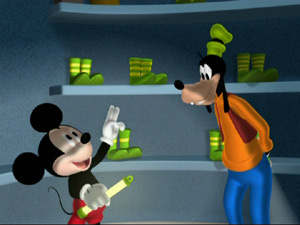
Mickey Go Seek is the final episode, and has the simplest plot. The whole episode is about Mickey looking for Donald while playing hide-and-go-seek. That’s it. Although there is not much that happens, the story surprisingly does not feel padded, as Mickey looks in various places and encounters his other friends while using his mouseketools to search for Donald. By the time we watched this third episode, my daughter and I had begun to shout at the screen whenever Mickey and his friends found they had to use up another of their precious mouseketools. We would cry out in anguish, “They’re burning right through them!” And then, oh, would we laugh!
…Maybe you had to be there. But the point is, we were getting into the show. That must say something, right?
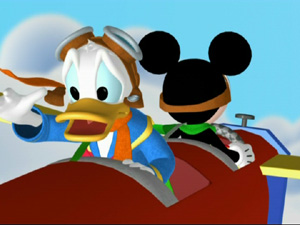
Those put off by a CGI Mickey will obviously not be enamored with the animation here, but for a television budget the characters move quite fluidly. (The animation, attributed to Walt Disney Television Animation, was done by DQ Entertainment, Limited, in India.) While there is little allowance for squash and stretch, there is a fair bit of “rubber hosing” built into the models. The computer rendering looks a little flat, but that’s largely a by-product of trying to add an extra dimension to characters meant to be drawn and colored in two. The same problem is seen with the big “ear issue”, as Mickey’s ears have traditionally been drawn to both be equally visible and not foreshortened no matter his position. This makes no sense in a 3-D world, where it more than ever looks like Mickey’s growing ears out of the top and back of his head when he’s in profile. Nevertheless, after a bit I was accepting of these 3-D versions of the Disney gang and found them to be relatively engaging. They still cannot match their drawn counterparts yet, though. It takes a lot of time, talent, and money to make CGI characters with soul, and that just cannot be managed easily on television.
Adding to the Disney tradition, the viewer is encouraged to look for a number of “hidden Mickeys” during each program. While many are obvious, there are a number of clever ones, such as in some tire tacks seen in Mickey Go Seek.
Is This Thing Loaded?
This is naturally a “Disney Fast Play DVD”, so it will play automatically, thereby bypassing any menus unless selected. While this may be a nice idea, I would find it eminently more useful if my child were not then forced to endure ads for other Disney DVDs.
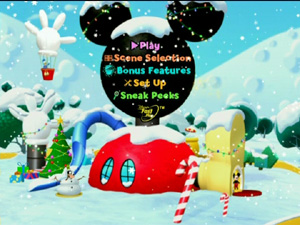
The menus are classily done, with the main menu being especially attractive, with snow falling down over a scene at the clubhouse, and the figures in the scene contributing some motion.
The actual bonus features are slim. A Hot Dog Dance Along is little more than a reprise of the show’s ending tune, spliced in with some footage from Goofy’s Bird. Then, there is a game called Mickey’s Picture Puzzle, where the viewer has to decipher simple images when given a choice of three different solution options.

Other than that, there are the requisite Sneak Peeks, including those for Meet The Robinsons, Robin Hood: Special Edition, The Fox And The Hound 2, Mickey Mouse Clubhouse, Disney’s Enchanted Tales: A Kingdom Of Kindness, Peter Pan: Special Edition, Mickey Mouse Clubhouse: Mickey’s Great Clubhouse Hunt, Disney DVD Game World, and Little Einsteins: The Legend Of The Golden Pyramid.
Case Study:
Like the case for Mickey’s Twice Upon A Christmas, the package for Mickey Saves Santa has a cover that is more suggestive of traditional animation, while the back cover is more revealing of the actual CGI content. There is nothing inherently wrong with that— live action movie posters are often painted, after all— but one does wonder if Disney is shy about displaying the CGI versions of the characters on the cover.
The case used is maybe ideal for parents who don’t want the kids getting chocolate sauce all over the disc when they are not looking. Disney used the type of case with the two snaps on it, so you cannot simply pull the case open. Good to keep discs clean when dealing with small ones, but for adults it turns a simple task into a three-step process.
Inside the case are, of course, some Disney advertising inserts.
Ink And Paint:
The video on this disc is vivid. The characters practically jump off the screen, and I saw no compression problems anywhere. Television CGI cartoons often come out looking edgy, but the picture in this show is smoooooth. While I would not have expected much from a disc of this type, it is nice to see that care was taken to give it the nicest possible visual presentation. This show is nothing if not bright (almost too bright!), and every color is shown to its greatest advantage. Even if the subject matter is not mesmerizing to mom and dad, the colors may entrance even some grown-ups.

Scratch Tracks:
The 2.0 sound is nice and crisp, though one is not shocked to find that the sound engineers did not pull out all the stops for this mix. Still, the songs do come out really nice, and if there is one thing that eventually won me over to liking this kiddie show, it was the infectious songs. From the jumpy beat of the opening to the concluding Hot Dog song by They Might Be Giants, each episode is filled with catchy tunes and background music. The same songs appear in each show, but they are brief enough to not become irritating.
Voice work, by the way, was done by some of the Disney regulars. Wayne Allwine, “Mickey Mouse” going back to Mickey’s Christmas Carol, is back for this series, as is his wife Russi Taylor as “Minnie”.

There are English and French tracks available, plus English captions for the hearing impaired.
Final Cut:
Be aware that this one is strictly for the kids. Mickey Mouse Clubhouse makes no pretense about being a show for everyone, but for small children the energy and learning quotient are enough to give the show a recommendation. The disc here has a brilliant picture, and adequate sound, with three simple stories that encourage active viewer participation. Though only the first story is about Christmas, the others provide the same treats that the show is designed to hand out.
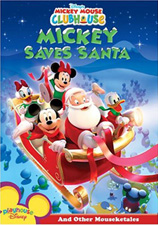 | ||
 |







